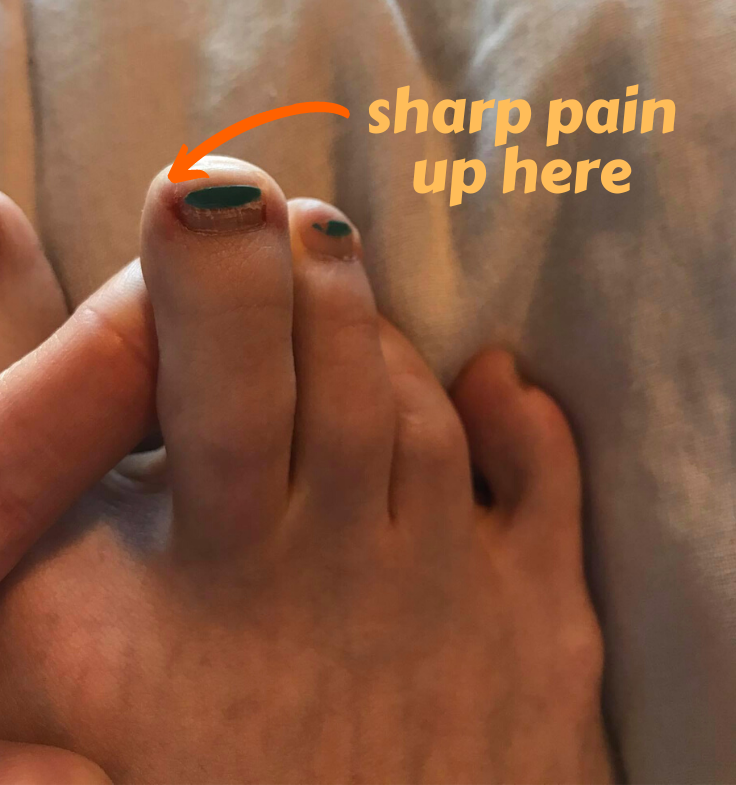
We had a patient come in to see us recently with the tip of her second toe being red, feeling tender and looking a little swollen. She had experienced ingrown toenails previously, and said it felt a little bit like that. Except this time, she had cut her toenails short a week or so prior – and the area that was painful wasn’t immediately down the side of her nail but above it, where the nail used to be before she cut it.
She wasn’t sure what was going on, if it was an ingrown nail, or if it was something else. We thought we’d share what happened in case you’re also feeling like you’ve got pain towards the top of your toe but your nails are trimmed short and the area of the pain isn’t where you’d expect, so you’re wondering whether it could still be an ingrown toenail or what could be causing your toe pain.
The actual toe pictured below (just for reference), about a week after we successfully treated it:
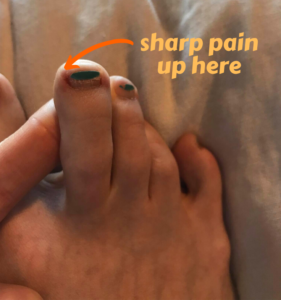
Second toe pain: Our patient’s story
When we examined her toe, it was extremely tender to touch in a particular spot only – and it wasn’t the toenail. (Note: pushing down on the toenail did cause a bit of pain, but only from the way that the pushing affected the painful area at the top of the toe). There was a small indent at the top of the toe where the pain was, and the entire tip of the toe was a little reddened and mildly swollen. Very tender to touch.
Examining the part that had indented, we found two things:
- A small corn in the crease – the skin was harder and firmer than the soft surrounding skin
- A small piece of the nail that had embedded into the nail crease – the crease created in the skin from the previous length of the toenail before it was trimmed
Understanding how this develops, we could see that the nail must have been rubbing against the skin when it was long for some time, which both produced the corn, and encouraged the edge of the nail to become embedded into the skin. Eventually, a small piece of the embedded nail broke off, and was left behind as it was trimmed.
Instant pain relief from treatment
If there’s anything good to come out of this case, it’s that for this patient, her treatment was quick and effective, with the sharp stabbing pain easily instantly after we removed both the embedded nail spicule and the small corn. This is because the swelling, redness and pain was a direct result of the nail spicule still being left behind, which was then made worse by the corn – so once we could remove both of these, the toe would be able to heal and any swelling and pain would subside.
This is a common mistake we see when patients treat their nails at home – they may trim their nails, but forget that while something foreign (and sharp!) is piercing the skin, the wound cannot close and heal. Getting it out can be tricky because the nail spicule can be difficult to see, difficult to remove, and painful when you’re using whatever you have at home to try to help, instead of our fine, specialised podiatric tools.
Within 5 minutes, we were able to remove the nail spicule, remove the corn completely, and then dress the toe. Our patient had immediate relief from the sharp stabbing pain, and while some tenderness lingered as there was still a small wound there, this had subsided by the next morning, along with the redness and swelling.
Our podiatrists make treating all sorts of ingrown toenails easy
We wanted to share this because while many ingrown toenails are ‘textbook’ – big toenail, down the side of the toe – as ingrown toenail specialists, we see plenty of ingrown toenails that are atypical, but that are still very effectively and simply treated.
We’re equipped with all the right tools to make treatment easy and stress-free, and unless you require ingrown nail surgery, can almost always treat and relieve your pain on the day. (If you require surgery we’ll always book you in for it as quickly as possible!).
Book your appointment with us by calling 09 523 2333 or book online here.
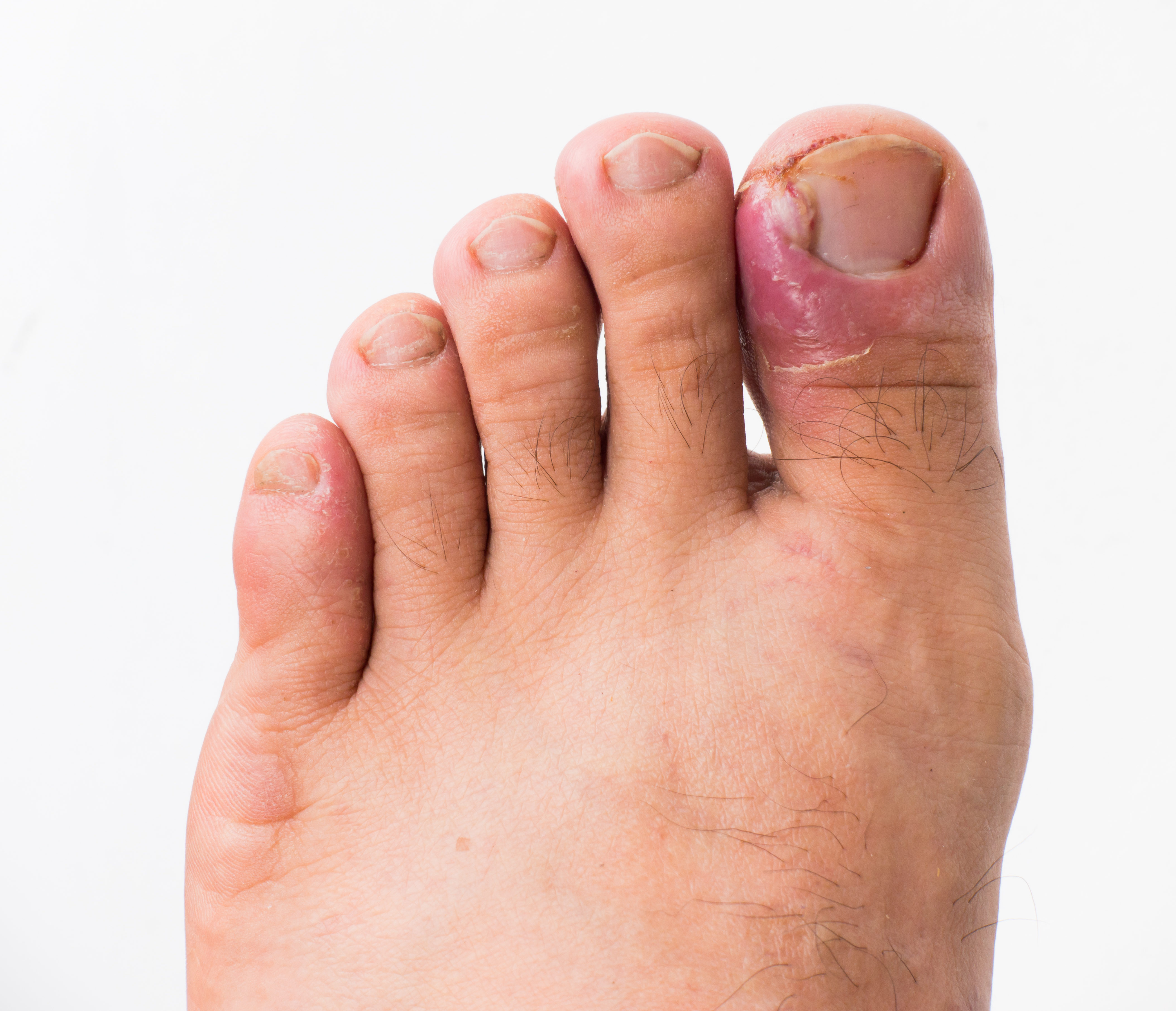
Ingrown toenails are painful and frustrating enough, so the last thing you want is to add an infection to the mix. Unfortunately, in our experience, a large number of ingrown toenails will get infected if proper treatment is undertaken – and it makes sense when you think about it.
Today, our ingrown toenail specialists will be sharing:
- Why the risk of developing an infection once you have an ingrown toenail is high
- What you can do to prevent an infection before it develops
- How you can treat your ingrown toenail and infection once it has occurred
You Have A Significant Risk Of Developing An Infection. Here’s Why
Let’s clear something up: ingrown toenails and infections are not a case of the chicken and the egg – the ingrown toenail comes first.
What classifies a sore toe as an ‘ingrown toenail’ is the moment that the sharp piece of nail goes from merely pushing against the surrounding skin, to actually piercing it and penetrating it.
Think about that for a second – you have a piece of nail that is now constantly inside the skin through a cut down the side of the nail. Every time you walk and move, it’ll move slightly with vibrations of pressures from shoes and socks. Ouch! This also means that while a normal cut occurs and then can heal, this cut can’t – because the ingrown toenail is still constantly piercing it and so keeping the cut open.
An infection occurs when bacteria and other nasties enter the body. Usually, our skin is a fantastic barrier, so while there may be many nasties around us regularly, they never have an ‘in’. Until now. And especially at the ground where you may walk barefooted. And when you give it a perfectly placed entrance – there’s a strong chance that the infection will take hold and start to develop.
Once the infection takes hold, it means increased swelling, pain and oozy discharge (and maybe blood) that is yellow/green/clear in nature and may ‘crust over’.
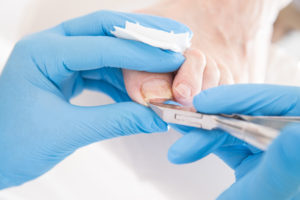
Preventing An Infection From Your Ingrown Toenail Before It Develops
So how, then, can we prevent – or at least reduce the risk – of developing an infection? It’s quite simple, really. And no – no Epsom salts required just yet!
As the cut from ingrown toenail creates an ‘in’ for the bacteria to take hold, the way to prevent an infection is to remove this ‘in’. This means removing the penetrating nail edge so that the cut can heal, close, and no longer be vulnerable to the infection. Simple, right? – Absolutely.
So How Do I Treat My Ingrown Toenail – And The Infection If I Already Have One?
The best way to ensure the proper care of your ingrown toenail is to see your Podiatrist. Our team here at the Ingrown Toenail Clinic are Podiatrists that are trained in simple and painless ingrown toenail surgeries, as well as conservative care where we safely remove that small, pesky nail edge in a matter of minutes. You’ll feel the relief almost instantly!
We don’t recommend trying to cut back the nail at home because often the nail runs much deeper than you can see, so most people will miss removing the complete penetrating edge and their pain will only continue to worsen. You also won’t have the right tools for the job – whereas we have everything needed to do it quickly and easily – even anaesthetic if you need or want it! (though most people don’t).
Once the sliver of nail is removed, the body will be able to effectively heal the wound and fight the infection – and of course, we’ll help it along by dressing it with betadine (antiseptic). You’re welcome to soak it in some Epsom salts too – but once the nail is out, it should be relatively simple and straightforward for it to heal and the infection to subside.
No more painful, swollen discharge – hooray!
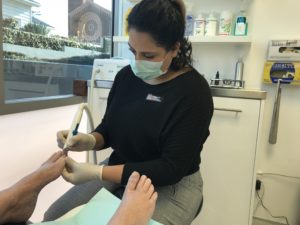
Auckland’s Ingrown Toenail Experts
We’re proud to be Auckland’s only Podiatry clinic that specialises in the safe and effective care of ingrown toenails – and we do a really good job of it. From simple and easy care to quickly remove the small nail edge, to minor nail surgery to permanently correct ingrown toenails, we’ve got you covered.
You can book online here or give us a call on (09) 523 2333.





